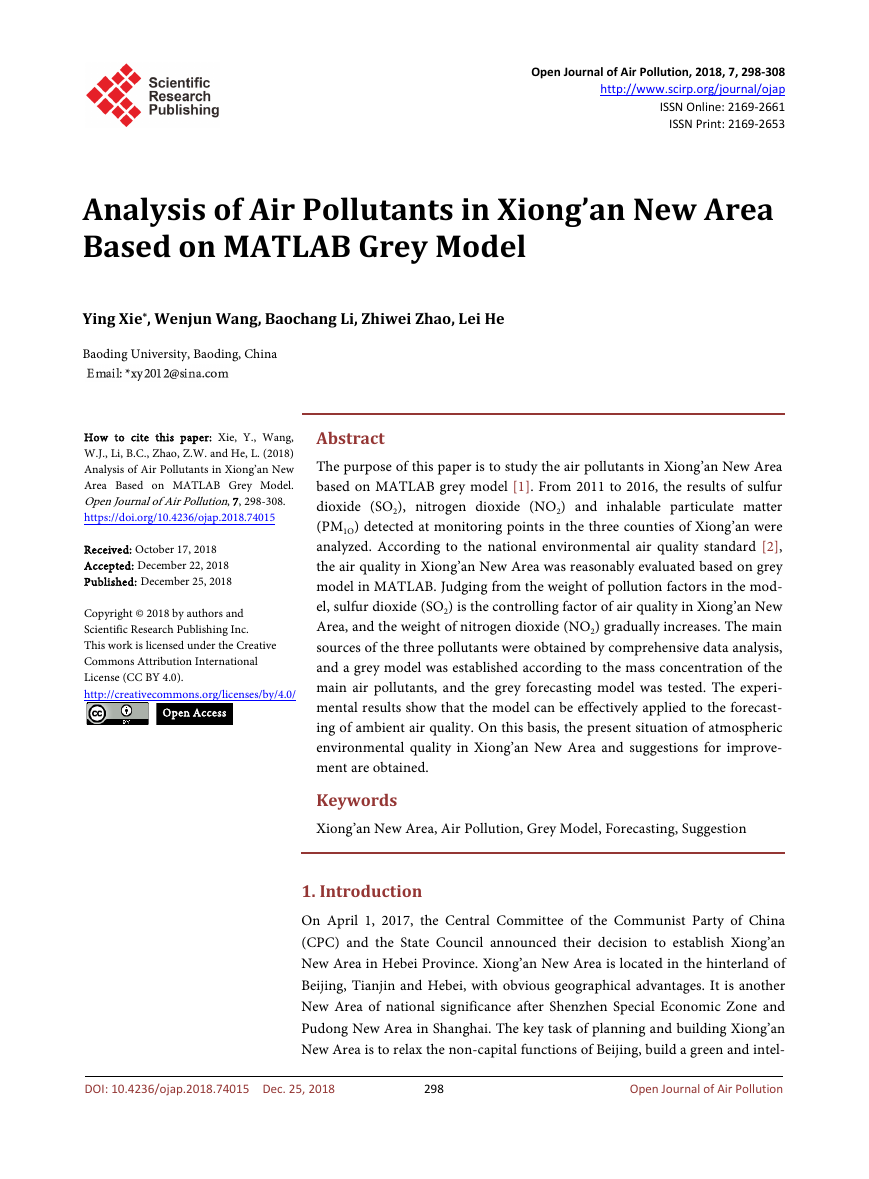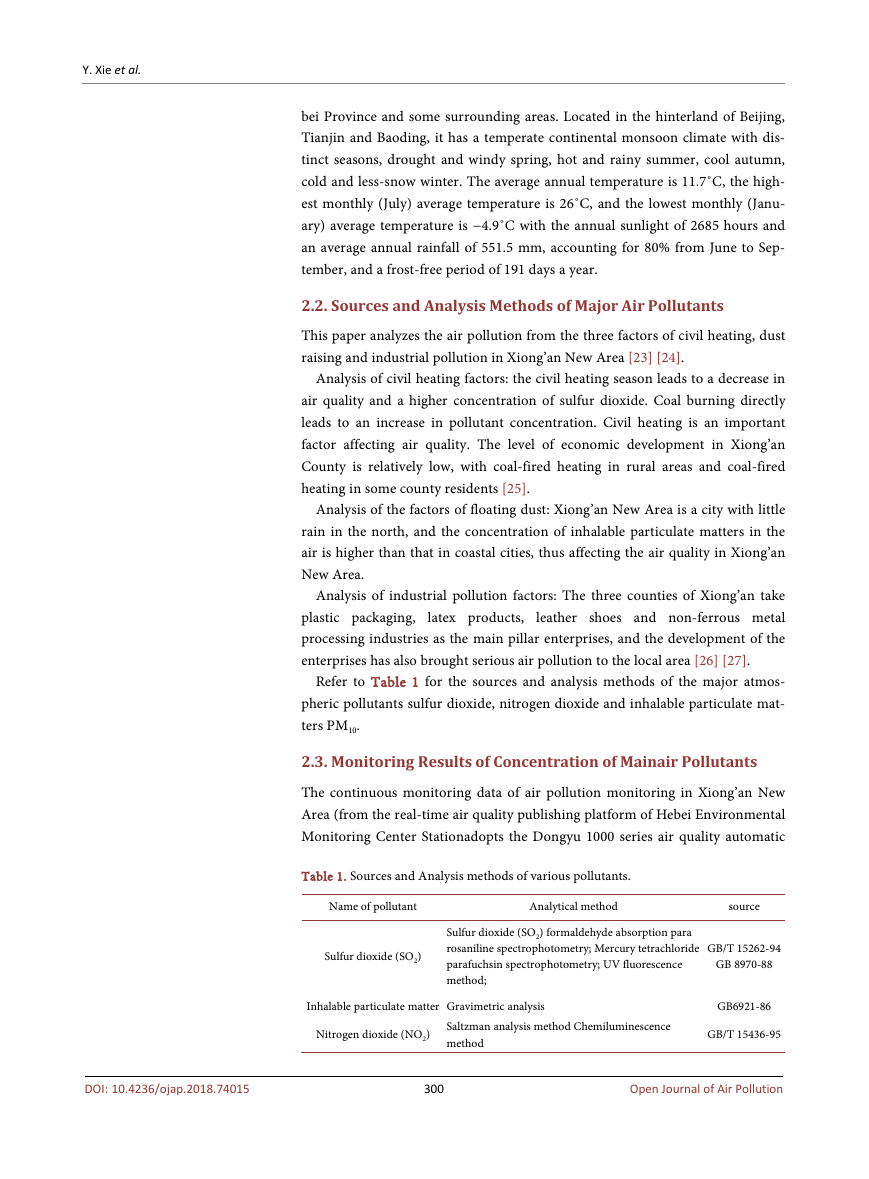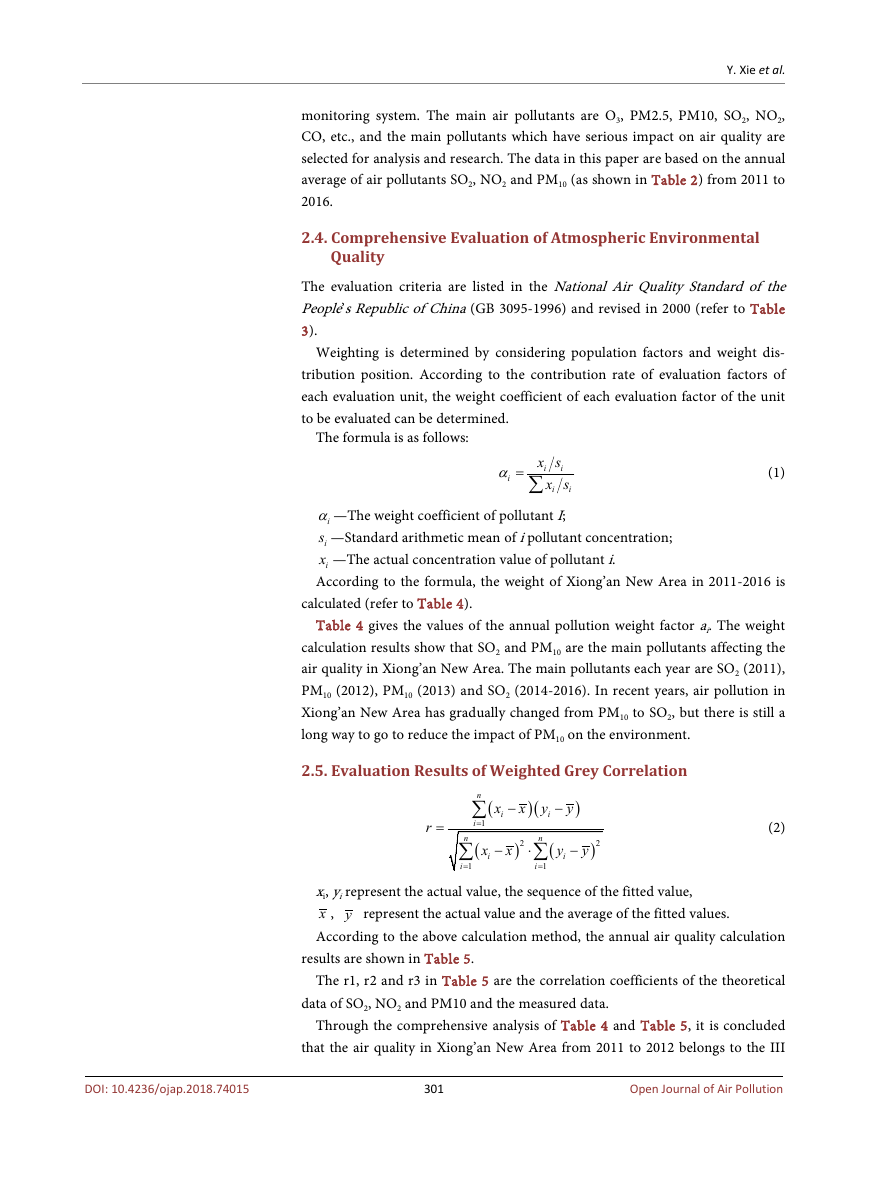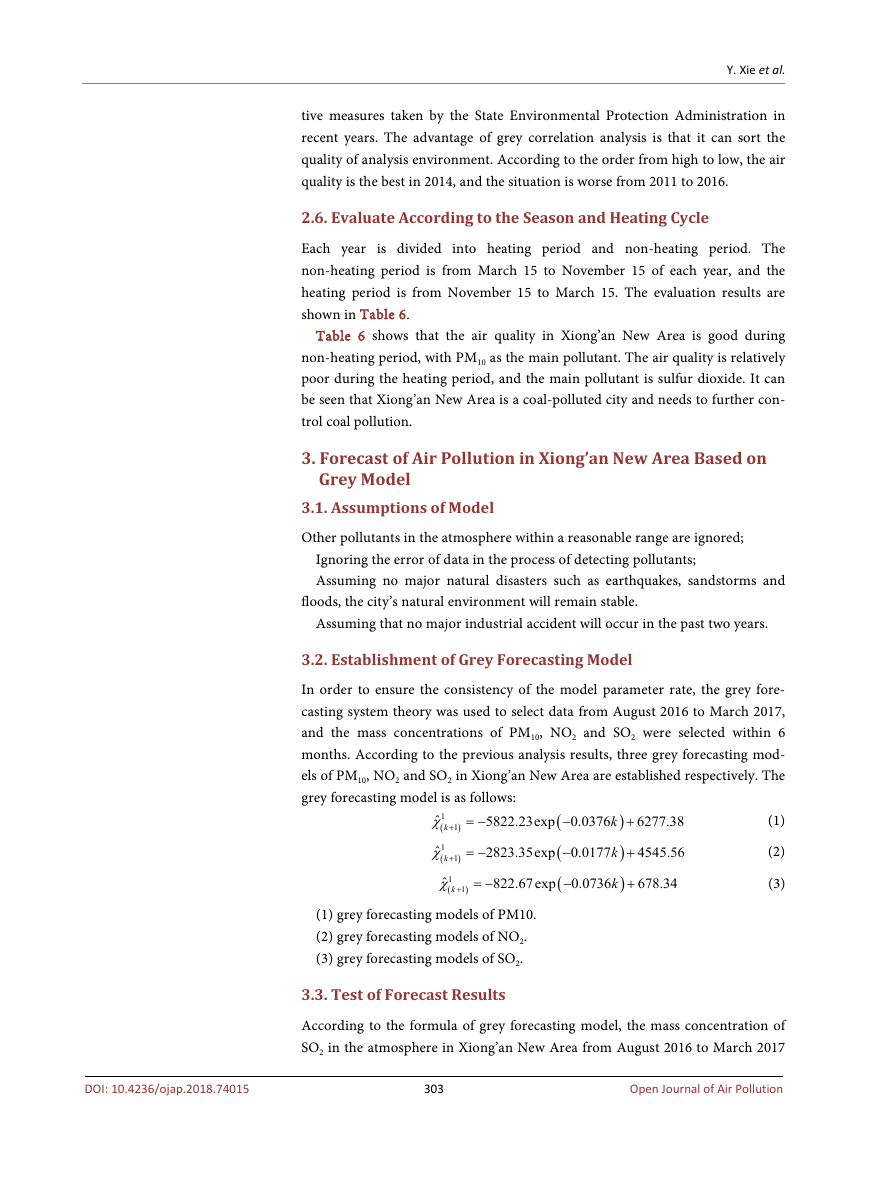Open Journal of Air Pollution, 2018, 7, 298-308
http://www.scirp.org/journal/ojap
ISSN Online: 2169-2661
ISSN Print: 2169-2653
Analysis of Air Pollutants in Xiong’an New Area
Based on MATLAB Grey Model
Ying Xie*, Wenjun Wang, Baochang Li, Zhiwei Zhao, Lei He
Baoding University, Baoding, China
How to cite this paper: Xie, Y., Wang,
W.J., Li, B.C., Zhao, Z.W. and He, L. (2018)
Analysis of Air Pollutants in Xiong’an New
Area Based on MATLAB Grey Model.
Open Journal of Air Pollution, 7, 298-308.
https://doi.org/10.4236/ojap.2018.74015
Received: October 17, 2018
Accepted: December 22, 2018
Published: December 25, 2018
Copyright © 2018 by authors and
Scientific Research Publishing Inc.
This work is licensed under the Creative
Commons Attribution International
License (CC BY 4.0).
http://creativecommons.org/licenses/by/4.0/
Open Access
Abstract
The purpose of this paper is to study the air pollutants in Xiong’an New Area
based on MATLAB grey model [1]. From 2011 to 2016, the results of sulfur
dioxide (SO2), nitrogen dioxide (NO2) and inhalable particulate matter
(PM1O) detected at monitoring points in the three counties of Xiong’an were
analyzed. According to the national environmental air quality standard [2],
the air quality in Xiong’an New Area was reasonably evaluated based on grey
model in MATLAB. Judging from the weight of pollution factors in the mod-
el, sulfur dioxide (SO2) is the controlling factor of air quality in Xiong’an New
Area, and the weight of nitrogen dioxide (NO2) gradually increases. The main
sources of the three pollutants were obtained by comprehensive data analysis,
and a grey model was established according to the mass concentration of the
main air pollutants, and the grey forecasting model was tested. The experi-
mental results show that the model can be effectively applied to the forecast-
ing of ambient air quality. On this basis, the present situation of atmospheric
environmental quality in Xiong’an New Area and suggestions for improve-
ment are obtained.
Keywords
Xiong’an New Area, Air Pollution, Grey Model, Forecasting, Suggestion
1. Introduction
On April 1, 2017, the Central Committee of the Communist Party of China
(CPC) and the State Council announced their decision to establish Xiong’an
New Area in Hebei Province. Xiong’an New Area is located in the hinterland of
Beijing, Tianjin and Hebei, with obvious geographical advantages. It is another
New Area of national significance after Shenzhen Special Economic Zone and
Pudong New Area in Shanghai. The key task of planning and building Xiong’an
New Area is to relax the non-capital functions of Beijing, build a green and intel-
298
Open Journal of Air Pollution
DOI: 10.4236/ojap.2018.74015 Dec. 25, 2018
�
Y. Xie et al.
ligent new city and create a beautiful ecological environment. Like other regions
in Beijing, Tianjin and Hebei, the three counties in Xiong’an New Area have
long been plagued by environmental pollution, especially atmospheric pollutants
[3] [4] [5] [6].
The pollutants in the atmosphere are mainly composed of chemical pollutants
and particulates, etc. In order to protect and improve the living environment of
human beings, many domestic scholars have investigated the air pollution in ci-
ties. The main pollutants in the atmosphere are atmospheric particulates, sulfur
dioxide and nitrogen oxides [7] [8] [9] [10] [11]. According to the situation of
urban air pollution, many experts consider and evaluate it from these three as-
pects. At present, grey system theory has become an important forecasting me-
thod, including decision-making, evaluation, planning and control, system anal-
ysis and modeling. (Grey system theory is based on the concept of associative
space, smooth discrete function and other concepts to define gray derivatives
and gray differential equations, and then use discrete data columns to build dy-
namic models in the form of differential equations, since this is the basic model
of the intrinsic gray system, and the model is approximate Non-unique, so this
model is a gray model, which is denoted as GM (Grey Model), that is, the gray
model is generated by using discrete random numbers to become random,
which is significantly weakened and more regular. A model of the equation form
facilitates the study and description of its changing process.) In particular, it has
a unique analysis and model building method, short time series of statistical data
and incomplete information systems [12] [13] [14]. Many researchers in China
have established a grey system, and many doctors and researchers have applied
the grey system to research [15] [16] [17] [18] [19].
There are few applications of the grey theoretical model in atmospheric envi-
ronment prediction. Using the powerful matrix function of MATLAB, there are
not many gray GM (1,1) model algorithms. (The gray model is generally ex-
pressed as GM(n,x) model, which means that the x variables are modeled by
n-order differential equations.) Based on the MATLAB grey GM (1,1) model,
this paper theoretically predicts the concentration of atmospheric pollutants in
Xiong’an New District.
2. Weighted Grey Relational Analysis Model of Urban Air
Pollution Index
Taking Xiong’an New Area as an example, the monitoring data of sulfur dioxide
(SO2), nitrogen dioxide (NO2) and inhalable particulate matter (PM10) were mo-
nitored at monitoring points in the three counties of Xiong’an from 2011 to 2016
[20] [21] [22]. According to the national environmental air quality standard, a
weighted grey correlation analysis model is used to make a reasonable compre-
hensive evaluation of the air quality in Xiong’an New Area.
2.1. Climatic Characteristics of Xiong’an New Area
Xiong’an New Area includes Xiongxian, Rongcheng and Anxin counties in He-
299
Open Journal of Air Pollution
DOI: 10.4236/ojap.2018.74015
�
Y. Xie et al.
DOI: 10.4236/ojap.2018.74015
bei Province and some surrounding areas. Located in the hinterland of Beijing,
Tianjin and Baoding, it has a temperate continental monsoon climate with dis-
tinct seasons, drought and windy spring, hot and rainy summer, cool autumn,
cold and less-snow winter. The average annual temperature is 11.7˚C, the high-
est monthly (July) average temperature is 26˚C, and the lowest monthly (Janu-
ary) average temperature is −4.9˚C with the annual sunlight of 2685 hours and
an average annual rainfall of 551.5 mm, accounting for 80% from June to Sep-
tember, and a frost-free period of 191 days a year.
2.2. Sources and Analysis Methods of Major Air Pollutants
This paper analyzes the air pollution from the three factors of civil heating, dust
raising and industrial pollution in Xiong’an New Area [23] [24].
Analysis of civil heating factors: the civil heating season leads to a decrease in
air quality and a higher concentration of sulfur dioxide. Coal burning directly
leads to an increase in pollutant concentration. Civil heating is an important
factor affecting air quality. The level of economic development in Xiong’an
County is relatively low, with coal-fired heating in rural areas and coal-fired
heating in some county residents [25].
Analysis of the factors of floating dust: Xiong’an New Area is a city with little
rain in the north, and the concentration of inhalable particulate matters in the
air is higher than that in coastal cities, thus affecting the air quality in Xiong’an
New Area.
Analysis of industrial pollution factors: The three counties of Xiong’an take
plastic packaging,
leather shoes and non-ferrous metal
processing industries as the main pillar enterprises, and the development of the
enterprises has also brought serious air pollution to the local area [26] [27].
latex products,
Refer to Table 1 for the sources and analysis methods of the major atmos-
pheric pollutants sulfur dioxide, nitrogen dioxide and inhalable particulate mat-
ters PM10.
2.3. Monitoring Results of Concentration of Mainair Pollutants
The continuous monitoring data of air pollution monitoring in Xiong’an New
Area (from the real-time air quality publishing platform of Hebei Environmental
Monitoring Center Stationadopts the Dongyu 1000 series air quality automatic
Table 1. Sources and Analysis methods of various pollutants.
Name of pollutant
Analytical method
source
Sulfur dioxide (SO2)
Sulfur dioxide (SO2) formaldehyde absorption para
rosaniline spectrophotometry; Mercury tetrachloride
parafuchsin spectrophotometry; UV fluorescence
method;
Inhalable particulate matter Gravimetric analysis
Nitrogen dioxide (NO2)
Saltzman analysis method Chemiluminescence
method
GB/T 15262-94
GB 8970-88
GB6921-86
GB/T 15436-95
300
Open Journal of Air Pollution
�
Y. Xie et al.
monitoring system. The main air pollutants are O3, PM2.5, PM10, SO2, NO2,
CO, etc., and the main pollutants which have serious impact on air quality are
selected for analysis and research. The data in this paper are based on the annual
average of air pollutants SO2, NO2 and PM10 (as shown in Table 2) from 2011 to
2016.
2.4. Comprehensive Evaluation of Atmospheric Environmental
Quality
The evaluation criteria are listed in the National Air Quality Standard of the
People’s Republic of China (GB 3095-1996) and revised in 2000 (refer to Table
3).
Weighting is determined by considering population factors and weight dis-
tribution position. According to the contribution rate of evaluation factors of
each evaluation unit, the weight coefficient of each evaluation factor of the unit
to be evaluated can be determined.
The formula is as follows:
α = ∑
i
x s
i
i
x s
i
i
(1)
iα—The weight coefficient of pollutant I;
is —Standard arithmetic mean of i pollutant concentration;
ix —The actual concentration value of pollutant i.
According to the formula, the weight of Xiong’an New Area in 2011-2016 is
calculated (refer to Table 4).
Table 4 gives the values of the annual pollution weight factor ai. The weight
calculation results show that SO2 and PM10 are the main pollutants affecting the
air quality in Xiong’an New Area. The main pollutants each year are SO2 (2011),
PM10 (2012), PM10 (2013) and SO2 (2014-2016). In recent years, air pollution in
Xiong’an New Area has gradually changed from PM10 to SO2, but there is still a
long way to go to reduce the impact of PM10 on the environment.
2.5. Evaluation Results of Weighted Grey Correlation
r
=
n
∑
i
1
=
(
x
i
−
x
)(
y
i
−
y
)
n
∑
i
1
=
(
x
i
−
x
2
)
⋅
n
∑
i
1
=
(
y
i
−
y
2
)
(2)
xi, yi represent the actual value, the sequence of the fitted value,
x , y represent the actual value and the average of the fitted values.
According to the above calculation method, the annual air quality calculation
results are shown in Table 5.
The r1, r2 and r3 in Table 5 are the correlation coefficients of the theoretical
data of SO2, NO2 and PM10 and the measured data.
Through the comprehensive analysis of Table 4 and Table 5, it is concluded
that the air quality in Xiong’an New Area from 2011 to 2012 belongs to the III
301
Open Journal of Air Pollution
DOI: 10.4236/ojap.2018.74015
�
Y. Xie et al.
Table 2. Monitoring results of air pollutants in Xiong’an New Area.
Year
2011
2012
2013
2014
2015
2016
SO2 (mg/m3)
NO2 (mg/m3)
PM10 (mg/m3)
0.134
0.137
0.084
0.079
0.077
0.063
0.033
0.039
0.036
0.025
0.022
0.032
0.109
0.107
0.098
0.109
0.097
0.087
Table 3. Grading standards for atmospheric environmental quality.
Pollutant
Sample time
SO2
NO2
PM10
Annual mean
Annual mean
Annual mean
Table 4. Weight calculation results.
Year
2011
2012
2013
2014
2015
2016
SO2
0.489
0.520
0.400
0.452
0.449
0.427
Limit concentration (mg/m3)
Ⅰ level standard Ⅱ level standard Ⅲ level standard
0.04
0.04
0.02
NO2
0.133
0.133
0.191
0.167
0.131
0.185
0.10
0.08
0.06
0.15
0.08
0.10
Weight coefficient
PM10
0.378
0.347
0.409
0.381
0.420
0.387
Primary pollutant
SO2
PM10
PM10
SO2
SO2
SO2
Table 5. Results of comprehensive evaluation in recent years.
Year
2011
2012
2013
2014
2015
2016
r1
0.528
0.433
0.529
0.137
0.422
0.467
Correlation degree
r2
0.650
0.502
0.810
0.623
0.846
0.816
r3
0.815
0.347
0.538
0.090
0.457
0.439
Quality level
Ⅲ level
Ⅲ level
Ⅱ level
Ⅱ level
Ⅱ level
Ⅱ level
level, that is, light pollution. From 2013 to 2016, the urban ambient air quality
was 2 and the air was good. This indicates that the ambient air quality in the
New Area is gradually improving. This good air quality benefits from the posi-
302
Open Journal of Air Pollution
DOI: 10.4236/ojap.2018.74015
�
Y. Xie et al.
tive measures taken by the State Environmental Protection Administration in
recent years. The advantage of grey correlation analysis is that it can sort the
quality of analysis environment. According to the order from high to low, the air
quality is the best in 2014, and the situation is worse from 2011 to 2016.
2.6. Evaluate According to the Season and Heating Cycle
Each year is divided into heating period and non-heating period. The
non-heating period is from March 15 to November 15 of each year, and the
heating period is from November 15 to March 15. The evaluation results are
shown in Table 6.
Table 6 shows that the air quality in Xiong’an New Area is good during
non-heating period, with PM10 as the main pollutant. The air quality is relatively
poor during the heating period, and the main pollutant is sulfur dioxide. It can
be seen that Xiong’an New Area is a coal-polluted city and needs to further con-
trol coal pollution.
3. Forecast of Air Pollution in Xiong’an New Area Based on
Grey Model
3.1. Assumptions of Model
Other pollutants in the atmosphere within a reasonable range are ignored;
Ignoring the error of data in the process of detecting pollutants;
Assuming no major natural disasters such as earthquakes, sandstorms and
floods, the city’s natural environment will remain stable.
Assuming that no major industrial accident will occur in the past two years.
3.2. Establishment of Grey Forecasting Model
In order to ensure the consistency of the model parameter rate, the grey fore-
casting system theory was used to select data from August 2016 to March 2017,
and the mass concentrations of PM10, NO2 and SO2 were selected within 6
months. According to the previous analysis results, three grey forecasting mod-
els of PM10, NO2 and SO2 in Xiong’an New Area are established respectively. The
grey forecasting model is as follows:
5822.23exp
2823.35exp
)
1
ˆ
1
χ + = −
(
k
ˆ
1
χ + = −
(
k
ˆ
1
χ + = −
(
k
)
1
822.67exp
)
1
(
(
(
0.0376
−
k
0.0177
−
k
0.0736
−
k
)
)
)
+
6277.38
(1)
+
4545.56
(2)
+
678.34
(3)
(1) grey forecasting models of PM10.
(2) grey forecasting models of NO2.
(3) grey forecasting models of SO2.
3.3. Test of Forecast Results
According to the formula of grey forecasting model, the mass concentration of
SO2 in the atmosphere in Xiong’an New Area from August 2016 to March 2017
303
Open Journal of Air Pollution
DOI: 10.4236/ojap.2018.74015
�
Y. Xie et al.
DOI: 10.4236/ojap.2018.74015
Table 6. Comprehensive evaluation results for the whole year.
Year
Term
2011
Heating period
2012 Non-heating period
Heating period
2013 Non-heating period
Heating period
2014 Non-heating period
Heating period
2015 Non-heating period
Heating period
2016 Non-heating period
Pollutant concentration (mg/m3)
Ⅰ level
Ⅱ level
Ⅲ level
Quality level
Primary
pollutant
0.373
0.642
0.519
0.607
0.466
0.679
0.552
0.483
0.452
0.694
0.515
0.801
0.610
0.776
0.557
0.645
0.775
0.801
0.543
0.820
0.584
0.701
0.675
0.416
0.766
0.392
0.834
0.416
0.792
0.453
III level
II level
III level
II level
II level
I level
III level
II level
III level
II level
SO2
PM10
SO2
PM10
SO2
PM10
SO2
PM10
SO2
PM10
is calculated. (See Figure 1) The forecasted value of the grey model is taken as
the input value, and the actual value is the output value. Iterate input and output
values. The maximum number of cycles is set to 5000 and the initial step size is
0.0001 m.
The data processing shows that the experimental data and the theoretical data
are basically fitted.
According to the formula of the grey forecasting model, PM10, NO2 and SO2
pollution in Xiong’an New Area (See Figure 2) will be obtained in the next 6
months, and the forecasting results of the grey forecasting model will be tested.
The accuracy of the model was verified by residual error test and posterior error
test. The results of the remaining tests are shown in Table 7.
4. Conclusion
Through the study of the air environmental quality in Xiong’an New Area from
2011 to 2016, it is found that the air environmental quality in the New District
has greatly improved in the past six years, and the air environmental quality
reached the III level in 2011 and 2012. Since 2013, the environmental quality has
been maintained at II level, meeting the national requirements. However, the
environmental quality is still in a state of constant repetition and it is necessary
to continue efforts. Secondly, the grey correlation method is used to comprehen-
sively analyze the air environmental quality in Xiong’an New Area. The results
are in line with the actual situation and reach the expected evaluation results
[28] [29] [30]. The grey correlation method is applicable to the comprehensive
evaluation of Xiong’an New Area’s air environment.
5. Suggests
“Green environmental protection, standards first” If Xiong’an New Area wants
to realize the development vision of green ecology and livability, it must
304
Open Journal of Air Pollution
�
Y. Xie et al.
forecast result
results of testing
4
6
8
10
12
14
16
18
20
)
3
-
m
c
.
g
(
n
o
i
t
a
r
t
n
e
c
n
o
c
2
O
S
240
220
200
180
160
140
120
100
80
60
Figure 1. Forecasting of SO2 Concentration in Xiong’an New Area from August 2016 to
March 2017.
Test points
y
t
i
’
C
n
a
g
n
o
X
n
i
i
2
O
S
f
o
n
o
i
t
a
r
t
n
e
c
n
o
c
e
h
T
0.14
0.12
0.10
0.08
0.06
0.04
0.02
0.00
6
8
10
12
14
16
18
20
22
Test points
Figure 2. Forecasting of SO2 mass concentration in Xiong’an New Area.
Table 7. The results of residual error test and posterior error test.
Time
2016.08
2016.10
2016.12
2017.02
Monitoring value
Forecasted value
Residual error
Relative error (%)
SO2
86.53
100.61
189.53
237.36
305
61.0388
121.1906
139.7011
185.6357
−18.88676
14.10033
17.14607
10.16509
18.43
17.24
7.79
21.79
Open Journal of Air Pollution
DOI: 10.4236/ojap.2018.74015
�
















 2023年江西萍乡中考道德与法治真题及答案.doc
2023年江西萍乡中考道德与法治真题及答案.doc 2012年重庆南川中考生物真题及答案.doc
2012年重庆南川中考生物真题及答案.doc 2013年江西师范大学地理学综合及文艺理论基础考研真题.doc
2013年江西师范大学地理学综合及文艺理论基础考研真题.doc 2020年四川甘孜小升初语文真题及答案I卷.doc
2020年四川甘孜小升初语文真题及答案I卷.doc 2020年注册岩土工程师专业基础考试真题及答案.doc
2020年注册岩土工程师专业基础考试真题及答案.doc 2023-2024学年福建省厦门市九年级上学期数学月考试题及答案.doc
2023-2024学年福建省厦门市九年级上学期数学月考试题及答案.doc 2021-2022学年辽宁省沈阳市大东区九年级上学期语文期末试题及答案.doc
2021-2022学年辽宁省沈阳市大东区九年级上学期语文期末试题及答案.doc 2022-2023学年北京东城区初三第一学期物理期末试卷及答案.doc
2022-2023学年北京东城区初三第一学期物理期末试卷及答案.doc 2018上半年江西教师资格初中地理学科知识与教学能力真题及答案.doc
2018上半年江西教师资格初中地理学科知识与教学能力真题及答案.doc 2012年河北国家公务员申论考试真题及答案-省级.doc
2012年河北国家公务员申论考试真题及答案-省级.doc 2020-2021学年江苏省扬州市江都区邵樊片九年级上学期数学第一次质量检测试题及答案.doc
2020-2021学年江苏省扬州市江都区邵樊片九年级上学期数学第一次质量检测试题及答案.doc 2022下半年黑龙江教师资格证中学综合素质真题及答案.doc
2022下半年黑龙江教师资格证中学综合素质真题及答案.doc